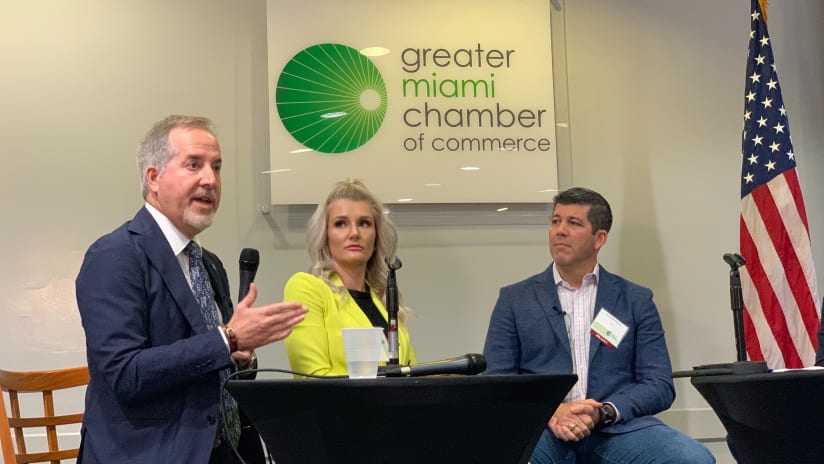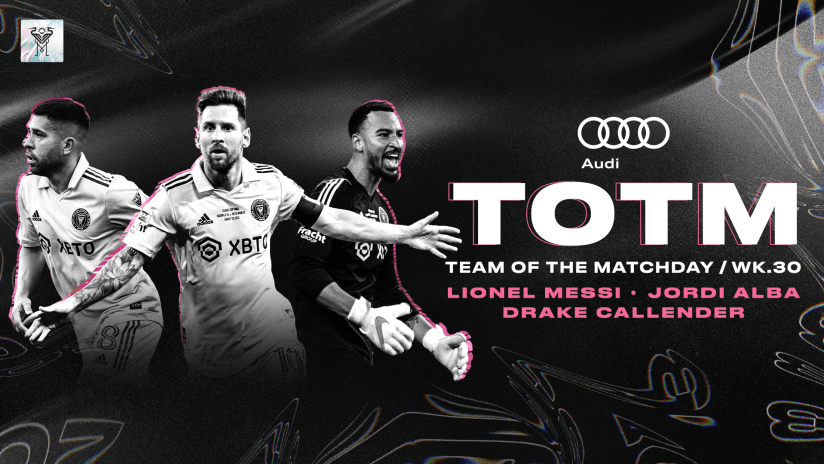Club Internacional de Fútbol Miami Managing Owner Jorge Mas was invited to speak on a panel titled “How to Build a World Class Stadium” for a Greater Miami Chamber of Commerce event last week.
Sitting on a stage alongside ESPN’s Fernando Palomo, former Canadian International Player Kaylyn Kyle and Architect Jose Ortiz, Mas shared thoughts on the evolution of stadiums and the vision for the Miami Freedom Park project.
“This is a very exciting path and journey that we’re on,” said Mas when asked about the Major League Soccer stadium experience and what makes it appealing. “When we got involved with MLS, I saw with an extreme amount of admiration and curiosity about how they were building MLS soccer-specific stadiums. Stadiums that were anywhere from 20-25,000 seats for soccer only, which had a very different design and feel than what our traditional, larger 60-70,000 (American football) stadiums had.”
“The in-game experience was amazing. Very different. It is two 45 minutes halves plus extra time that you do not get out of your seat for. You have a 15-minute break. That is when you get your food and beverage, which is a very different experience then in our three- and four-hour sports. But before everyone goes home after the second half, there is a postgame activity around the stadium for fans to cheer and talk about the game. This type of experience we should aspire to build in Miami.”
When asked what makes a stadium successful, Mas said, “I am a huge believer that stadiums on their own, stand-alone are not viable. They are not economic engines and drivers. Stadiums are an anchor and thrive when surrounded with something that can provide supplemental activity around it. Stadiums need to have life other than just the 17 or so games plus playoffs, so we have aspired to build a soccer village and entertainment pavilion that can attract fans and unite them around activities that go beyond the game.”
“I think we have been at the forefront of designing the kind of stadium we will see in the future in the United States,” he added.
Mas, who was born and raised in Miami to Cuban parents, also emphasized the importance of representing South Florida through Inter Miami, the newest MLS franchise set to begin league play in March of 2020 at the Fort Lauderdale stadium and training complex until Miami Freedom Park is complete.
“You look at David Beckham’s experience. He did not have to choose Miami. When he came into the league and he was given an option for a franchise he basically had a blank slate. He chose Miami because there’s something about Miami that talks to him, just like it does so many people who visit here and become enamored with our city.”
“Miami is a wonderful city. It’s a cultural mosaic. It is a truly global city, which if you asked me to describe in one word it would be: passion. How do you capture that in the infrastructure and create a stadium that is architecturally significant and iconic,” asked Mas. “Because I agree wholeheartedly, that we need to make the stadium experience a very good one for all people. Either, for the person who wants to go with his family and can only afford a $30 ticket or the person who wants a very high-end VIP experience that a lot of Miamians have become accustomed to.”
Mas and the group later discussed how to engage with fans before stadiums open.
“I enjoy watching the supporters during the game as much as I do the game. Everything that we’ve done with our team, our design sessions at the architect’s office, has included our supporters.”
When talking about considerations to keep in mind for supporters when the stadium opens, Mas said, “Technology is the future of stadiums. There are so many things you are going to be able to do via your phone, via technology, via holograms, via artificial intelligence that is important to consider for the fan base.”
The panelists switched the conversation to discuss the importance of considering location for stadiums, including the Miami Freedom Park project.
“When you look at the site of Miami Freedom Park, where the current Melreese Golf Course is, it’s literally in the center of our city. Public transportation is literally 200 yards from where the stadium is going to be located. It’s a site that allows us to build something that can be an economic engine, an economic driver for our city. Because solely investing in a stadium doesn’t bring benefits.”
“The entertainment and food and beverage facilities outside, and the hotels, are important aspects of the project. But most importantly the project comes at zero cost to the taxpayer. Zero. This will be the only stadium and facility in the country that will pay a fair-market lease for the land and pay property taxes. There is no other stadium in the United States of America that does that. The reason that it is zero cost to the city is that there’s an investor group willing to invest in the whole project and invest in our city. This is a project that will bring 11,000 construction jobs, and 4,000 permanent well-paying jobs. It is one of the only projects in the country that will offer a $15 minimum wage. It will generate taxes to the city, county, schoolboard, and state in excess of $40 million a year. If you look at just a 20-year timeline, you are close to $1 billion dollars in fiscal benefits, besides the economic drivers of employment and all of the additional benefits that it brings. That’s why this site is important.”
Lastly, he spoke about the global attention Club Internacional de Fútbol Miami brings South Florida as a whole.
“I think Inter Miami and Miami Freedom Park will bring a significant amount of global attention and visitors to our community. I think that what we’re preparing and what we’re presenting to our city is something which is unique, something that’s iconic and something that I think 50 years from now we can look back and say this still lives, still talks to people. And again, it is a stadium that is not built for 17 or 20 games. It’s a stadium that’s built for our community to gather.”
“This is the people’s project.”




